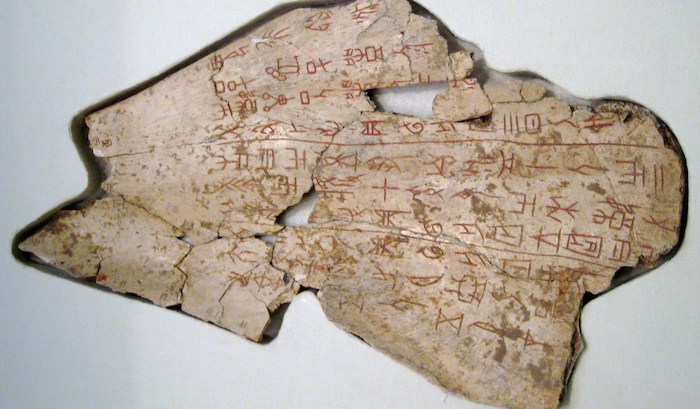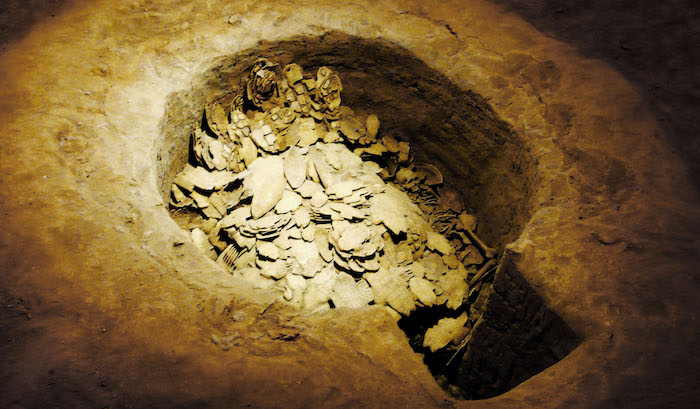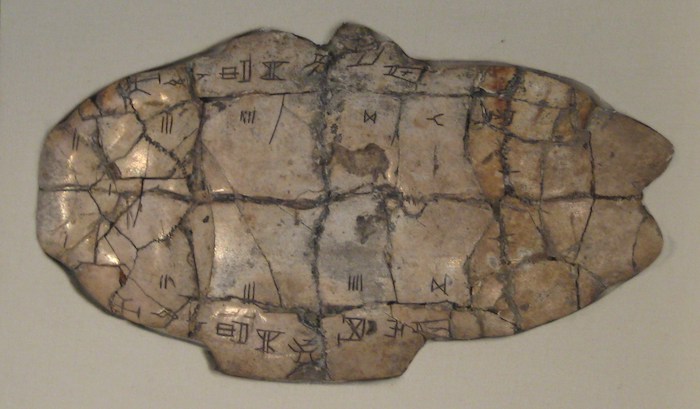China’s Shang dynasty ruled a Bronze Age proto-state that used a lot of divination to inform the king’s decisions. The pyromancy that Shang officials wielded to understand their world left a rich trove of documentary evidence: oracle bones covered in burns and writing. They’re a great fit for RPG campaigns, even ones that don’t have magic!
This post is brought to you by beloved Patreon backer Arthur Brown. Thanks for helping keep the lights on! If you want to help keep this blog going alongside Arthur, head over to the Patreon page – and thank you!

The Shang dynasty governed the Yellow River Valley from roughly 1600 to 1045 B.C. It was one of several small proto-states that existed at the time, but it was the only one to have produced written records that still survive. Orthodox Chinese historiography holds the Shang state to be ‘China’ (unlike its peer states, which don’t count), and the Shang dynasty is traditionally held up as the second Chinese dynasty – though the preceding one that the Shang replaced might not have actually existed. A lot of scholars went to a lot of trouble over thousands of years to streamline Chinese history into a single coherent narrative, and modern historians are still working out which parts of the orthodox narrative stand up to scrutiny. Still, even if the real Shang state wasn’t exactly like its portrayal in the classical Chinese canon, it was definitely real, interesting, and important.
One of the coolest sources of information we have about the Shang state is writings on oracle bones. A diviner – sometimes the king, but often his representative – stood over a cattle shoulder blade or the belly section of a turtle shell. He would make a declaration like “Strong winds will come from the west tomorrow” or “This season there will be no floods.” Then he’d take a heat source (maybe a brand) and apply it to the bone. The bone cracked, and the diviner interpreted the shape of the crack as being either auspicious or inauspicious. If auspicious, the declaration was likely to come true. If inauspicious, the declaration was likely false. Often, someone would then write down on the bone the date, the declaration, and the interpretation. Sometimes someone would come back later and write down what actually happened. After a while, the bone would be moved to a storage pit at the royal capital at Yinxu, outside modern Anyang. Chinese historians have known about these pits and the writing inside since at least 1899. They’re the oldest surviving body of written material in East Asia.
It’s possible that oracle bone divinations were more than ways to probe the future, that the king had some power to make his tested declarations come true. Certainly it seems that the divinations were bound up in the very idea of kingship. Some bones suggest that the king’s information came from his royal ancestors, who spoke to him by making the bones crack in the right ways.

From references in the oracle bones, we can learn a fair bit about the Shang and their world. For example, we can learn about the Shang’s neighbors, whom they called ‘Fang’. There were many different Fang: the Renfang to the southeast, Tufang to the north, the Gongfang to the west, etc. The word ‘Fang’ translates roughly as ‘country’. For the etymology nerds in the audience, the words even have a similar etymological history, as ‘Fang’ comes from a word for ‘beside’, while ‘country’ comes from the Latin contra, ‘against’. The Shang recognized several Fang countries and four Fang spirits: one in each of the cardinal directions. The oracle bones concern themselves with both kinds of Fang. We have oracle bones testing declarations about the Fang countries like “The Fang will attack the capital” and “If the king joins with Zhi Guo to attack the Tufang, he will receive abundant assistance.” But we also have bones testing declarations about the Fang spirits like “If we pray for harvest to the Fang, we will receive it.”
Sometimes the Shang king was concerned that Fang attackers might be acting as agents of the divine vengeance of Di, the Shang high god. (The subsequent Zhou dynasty would replace Di in state religion with a new prime mover, Tian, often translated as ‘heaven’.) For example, we have this tested declaration: “That the Fang are attacking us is because Di is ordering them to punish us.” We have another scapula fragment that contains two tested declarations: “Because the Fang are attacking us, we will raise men” and “It is not Di who orders the Fang to make disasters for us.”
One of the coolest oracle bones we have comes from a Shang war against the Renfang in the 11th century B.C. Every ten days while out on campaign, the king tested the same declaration: “In the next ten days, there will be no disasters.” He used the same piece of ox bone for each divination, progressively working his way down the bone as it filled up with writing. At the end of the war, the priests dutifully brought the bone back to the capital and put it in a storage pit.

Image credit: Chez Cåsver (Xuan Che). Released under a CC BY 2.0 license.
It’s easy to add a fictionalized version of Shang oracle bones to your ongoing campaign. Just declare that a relevant government uses this oracular process to see the future. It doesn’t matter whether the divination actually reveals the future, just that the queen or senate or government agency or whatever believes the process works. Then have the PCs accidentally stumble into possession of some oracle bones.
The servant responsible for gathering up the bones and moving them to storage is a traitor. She stashed an important bone someplace and alerted the king’s enemies where they could find it. These enemies could be foreign adversaries, political rivals, rebels, conspirators, or whatever works for your campaign. We’ll call them the Fang for simplicity. Before the Fang could reach the bone, the PCs accidentally got their hands on it. Maybe the transfer point was somewhere the PCs were looting and they took the bone. Maybe they found it in the street and recognized that it was valuable. Maybe it got mixed in with the reward from their last quest. Whatever the reason, the PCs have an oracle bone now.
The bone in question was used five times, each time ten days since the last time, and each time to test the declaration “In the next ten days, there will be no disasters from the Fang”. Each tested declaration is followed by a written “Results auspicious”. The most recent test happened yesterday. This bone is very important to the Fang: it indicates that the government believes there will not be a Fang-related disaster in the next nine days. Now is the perfect time for the Fang to strike, while the government’s guard is down. Since the bone is important to the Fang, that means the bone is also important to the government, who want to keep the bone out of Fang hands. There’s also the risk (or the perceived risk, if magic isn’t actually real in your setting) that the Fang might give the oracle bone to the Fang Powers, who might be able to interfere with the king’s ability to make this specific prediction come true.

The Fang know where the bone was supposed to be, because the traitor tipped them off. That means the Fang should be able to track the PCs who ran off with the bone. And the government knows where the bone is, thanks to their divination magic. If divination magic doesn’t really work, the first two tested declarations of where the bone is (and where the PCs are) turn out to be correct by coincidence.
The PCs would be wise to pick a side: Fang or government. Naturally, whichever side they prefer is the second to find them. The side they don’t like reaches the party first. This provokes a bit of cat-and-mouse as the party tries to keep one step ahead of their enemies and link up with their allies. These sorts of segments are a lot of work to prep, but a lot of fun to improvise. Just come up with a few generic obstacles you can throw at your party, and resist the urge to prepare for every possible move they could make.
Some parties might try a third option: destroying the bone. Let this backfire on the PCs. The government will believe this is a ruse and keep trying to arrest the PCs. After all, who would destroy something so valuable and sacred? The Fang, by contrast, will totally believe the PCs would destroy the oracle bone. But they’ll be angry about it and will keep trying to capture the party to enact revenge.
If the first part of this short adventure is a cat-and-mouse game, the second part should be dealing with the fallout of whichever side gets the bone. We already know that if the Fang get their hands on the oracle bone, they’ll undo the prophecy and launch some sort of attack or scheme that the government won’t be able to stop. If the government gets the bone back, they’ll feel this is vindication of the initial prophecy. While there could have been a disaster, there actually wasn’t – just as the oracle bone said there wouldn’t be. Secure in this prophecy, the government will do something incredibly dangerous. If oracular magic is real, it will work – with astonishing consequences. If oracular magic isn’t real, it won’t work – and the consequences will be terrible.

Enjoy this post? Consider sharing it on Facebook, Twitter, or Mastodon to increase visibility for the Molten Sulfur Blog!
Source: The Ancestral Landscape: Time, Space, and Community in Late Shang China (ca. 1200-1045 B.C.) by David N Keightley (2000)






